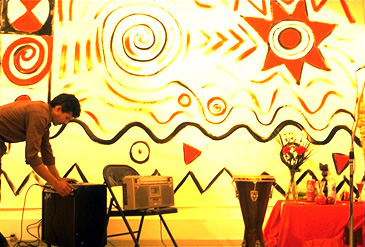 All
this reminded me of something that happened nine years ago. It was a very hot
and humid summer. I lived on Seventh Street between B and C. I went out to get
some groceries. At St. Marks Place I stopped and browsed around at what was
being sold on the street. Lots of junk, as usual, hot bicycles and other wares.
And there, in the middle of the chaos was sitting a young man, clean shaven,
dressed in black. In front of him on the pavement was a piece of blue velvet
on top of which were three or four religious pieces. I bought a silver cross
from him and left. On my way home I heard some Latin music and singing from
a small church. There was a man standing at the door. I wanted to take a peek.
He said: "Come in, come in." I stepped in. A young girl with a pretty face in
a white lace dress approached me. She said "I will translate to you; I will
be your Guide." She took me by the hand and sat me down, next to her. I was
enjoying the music, singing with percussion, congas and guitars. It was wonderful.
I turned to the girl and told her that it gave me shivers how beautiful it was.
She said that meant I was in the presence of God, then got up, went to the front
and whispered something in the priest's ear. Then the priest came to the microphone
and spoke. People started turning around and looking at me. His speech became
more and more passionate, he pointed at me. The priest said that he had a message
from God and that I was sent to them to be purified from Sin. He asked me to
step to the altar. I had no way out, so I proceeded. I came to the front, he
told me to lean down. A woman was on the other side of him. They laid their
hands on me and started screaming for the Devil to come out. Then they started
playing a rhythm on the drums and chanting I looked to the left, to the right;
people were turning in circles like dervishes, going into a frenzy. A woman
was crying. They poured water on the ground, on me. Then, slowly everyone settled
down. I gave the cross I had bought earlier to the girl, excused myself, took
my groceries and left. As I crossed the street to my door, put the key in, a
torrential flood of rain suddenly descended. This sent a chill through me; I
ran up all six flights of stairs in one breath. When I walked in my lower body
was covered with blood.
All
this reminded me of something that happened nine years ago. It was a very hot
and humid summer. I lived on Seventh Street between B and C. I went out to get
some groceries. At St. Marks Place I stopped and browsed around at what was
being sold on the street. Lots of junk, as usual, hot bicycles and other wares.
And there, in the middle of the chaos was sitting a young man, clean shaven,
dressed in black. In front of him on the pavement was a piece of blue velvet
on top of which were three or four religious pieces. I bought a silver cross
from him and left. On my way home I heard some Latin music and singing from
a small church. There was a man standing at the door. I wanted to take a peek.
He said: "Come in, come in." I stepped in. A young girl with a pretty face in
a white lace dress approached me. She said "I will translate to you; I will
be your Guide." She took me by the hand and sat me down, next to her. I was
enjoying the music, singing with percussion, congas and guitars. It was wonderful.
I turned to the girl and told her that it gave me shivers how beautiful it was.
She said that meant I was in the presence of God, then got up, went to the front
and whispered something in the priest's ear. Then the priest came to the microphone
and spoke. People started turning around and looking at me. His speech became
more and more passionate, he pointed at me. The priest said that he had a message
from God and that I was sent to them to be purified from Sin. He asked me to
step to the altar. I had no way out, so I proceeded. I came to the front, he
told me to lean down. A woman was on the other side of him. They laid their
hands on me and started screaming for the Devil to come out. Then they started
playing a rhythm on the drums and chanting I looked to the left, to the right;
people were turning in circles like dervishes, going into a frenzy. A woman
was crying. They poured water on the ground, on me. Then, slowly everyone settled
down. I gave the cross I had bought earlier to the girl, excused myself, took
my groceries and left. As I crossed the street to my door, put the key in, a
torrential flood of rain suddenly descended. This sent a chill through me; I
ran up all six flights of stairs in one breath. When I walked in my lower body
was covered with blood.
I never had an explanation
of what transpired that day. But now I was getting an inkling. Certainly it
wasn't a purely Christian affair. It was more like a shamanistic ritual. It
must have been a Santeria church that I walked into.
Santeria is not confined
to the ignorant and the uneducated. Some of the people I met who are followers
of the cult are real intellectuals. There are some 100 million practitioners
of the cult in Latin America and the U.S., and that is a conservative estimate.
In Cuba, where Santeria has developed extensively, the Yorubas are known as
lucumi This term is derived from the Yoruban word Akumi, which is the
name given to a native of Aku, a region of Nigeria where a lot of the Yorubas
come from. The Cuban lucumis were influenced by the Catholic imagery, although
the essence of the religion is purely African. I was delighted to have met Beatrice.
She was from Cuba and an anthropologist! At the panel meeting she said that
her mother, Rosa Levya "Shango Laramie," was a priestess, and many times wanted
her to become one too. She resisted, saying that she was interested in anthropology,
to which her mother responded that there is no difference, and that one day
she would have to face her destiny. It was her mother who initiated Basha into
the Yoruba religion.
The ceremony of initiation
was renamed asiento in Cuba, a Spanish word which means seat. The choice of
this word may be explained by the fact that the saints are believed to take
possession of their initiates and literally "mount" them. The santera is commonly
known as the "horse" of the saints. It is almost identical in the Voodoo religion.
During the initiation, the mind is conditioned for its future work. One is initiated
into the mysteries and rites of the particular Orishas who are recognized as
the "Mother" and the "Father."
When Castro came to power,
many Cubans fled the country, bringing with them the African rituals and magic.
Soon it spread throughout the South, particularly New Orleans and Miami, as
well as New York and New Jersey. Who would believe that the city that symbolizes
the height of civilization and modernity has so many practitioners of this cult!
But in New York you can see numerous botanical, which are the centers for practitioners.
These stores were opened by women originally, and they are where you can purchase
your candles and potions. And for a fee, it can be arranged for someone to cast
or rid a spell. Sometimes it is quite costly, all depending on the seriousness
of the situation at hand.
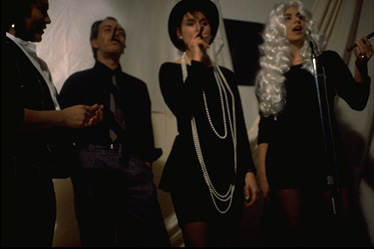 The
Havana cigar is considered by connoisseurs to be the creme de la creme. It has
been a forbidden fruit since 1959, when the U.S. put an embargo on Cuban tobacco.
And the symbol of the capitalist world, many times seen in Communist caricatures,
suddenly became readily available in the Soviet Union. And so Cuban magic traveled
to Russia. Meanwhile Castro recently received an award from the United
The
Havana cigar is considered by connoisseurs to be the creme de la creme. It has
been a forbidden fruit since 1959, when the U.S. put an embargo on Cuban tobacco.
And the symbol of the capitalist world, many times seen in Communist caricatures,
suddenly became readily available in the Soviet Union. And so Cuban magic traveled
to Russia. Meanwhile Castro recently received an award from the United
Nations for quitting the
cigar! Many Cubans believe that Castro owes his success to the black magic of
the Cuhan mayomberos (witches). It is rumored that the African deities
placed him in his position of power. In fact, quite a few dictatorships in Latin
America have been credited to works of magic. Only recently, when Noriega fled
from the U.S. troops, they found remnants of a magic ritual in his room. Animal
parts candles, offerings. And the New York Ames reported that he always
wore Red underwear as a means of protection.
Cuba has a peculiar history
owing largely to its geographical placement. Less than 90 miles from the Florida
Keys, it commands the entrance to the Gulf of Mexico and the Panama Canal. Now
that Noriega has been ousted and the Soviet Union has gone broke, it finds itself
isolated. The Indians who inhabited the island at the time of Columbus's landing
possessed no written language and because they were peaceful were annihilated
or absorbed, or else died out. At least three cultures swept through the island
before the arrival of the Spaniards: the Guanahatabeyes, the Ciboneyes, and
the Tainos, whom Beatrice mentioned earlier.
Most is known of the last
group. They had a rather advanced economic system based on agriculture. Tobacco,
cotton and corn were the most important part of the economy. The Tainos believed
in a supreme invisible being and their religion was idolatry. Ancestor worship
was common and they carved idols that resembled their ancestors. Tobacco was
used for smoking as well as for religious ceremonies and for curing the ill.
There was almost no mingling of races between the Spaniards and the Indians.
But the black slaves did have contact with the Indians. After all, their cultures
weren't that far apart from one another. They both worshipped nature, above
all, and their ancestors. Beatrice Morales spoke about this connection.
Emilia's Monday morning
cigar-smoking was a reenactment of an ancient Indian ritual. Beatrice translated
a description of the ritual from Spanish:
The rebel Indians communicated
with their ancestral warriors by keeping their bones in a clay pot and smoking
tobacco; this pleased the ancestors and ensured victory. One of the most interesting
rituals in the Afro-Cuban spiritual houses is the peculiar way in which the
mediums smoke tobacco. The Afro-Cuban medium, and all the spiritistas, place
the lit part of the cigar in their mouth, and they inhale the smoke in this
way, without breathing or opening the mouth. At the stream end of the cigar,
which is not lit, they exhale the smoke which reaches out into a fine, beautiful
line and leaves a trail of aroma in the air, covering the room. And thus they
sit in a circle. The tobacco ritual prepares the environment so that the group
can transcend their everyday world. The power of culture is amazing. In the
same way, we can see that tobacco was being smoked 500 years ago by the indigenous
people in the Caribbean. This ritual was passed on to the Afro-Cuban women who
were the traders of tobacco. Some people believe that tobacco is symbolic of
the AfroCuban culture. It's a combination of strength; and it's composed of
different cultures÷the AfroSemitic culture, which goes back to the 13th and
14th centuries when the Moors, Africans, Jews, and Gypsies formed a minority
in Spain. We know that there was a lot of cultural assimilation going on when
they came to Cuba in the 15th and 16th centuries....
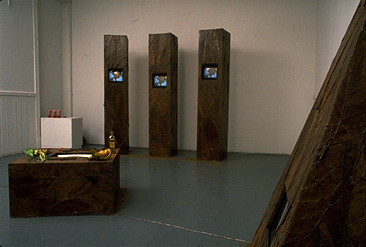 The
Yoruba tradition, as well as the Indian, was written down for the first time
when it came to Cuba. Familiar symbols began to emerge as I read about Shango.
Shango is a storm deity of the Yoruba. Each town or village in Nigeria has its
own Orisha who acts as a patron saint and protector of the people. Shango is
worshipped in the city of Oyo. This divinity was once a king, a strong ruler
and a great doctor. But he was also tyrannical. He could kill people by breathing
fire from his mouth.
The
Yoruba tradition, as well as the Indian, was written down for the first time
when it came to Cuba. Familiar symbols began to emerge as I read about Shango.
Shango is a storm deity of the Yoruba. Each town or village in Nigeria has its
own Orisha who acts as a patron saint and protector of the people. Shango is
worshipped in the city of Oyo. This divinity was once a king, a strong ruler
and a great doctor. But he was also tyrannical. He could kill people by breathing
fire from his mouth.
There are different versions
of the story of how Shango fled to the forest and eventually hanged himself.
But all agree that the place of this tragic event was Koso. This shameful event
was mocked by his enemies and they cast scorn on his name. So his friends contacted
a great magician who summoned a series of thunderstorms, causing the devastation
of the city of Oyo. His followers immediately proclaimed that the storms were
caused by Shango's anger. Many sacrifices were made in his honor and his followers
to this day proclaim "oba ko so," meaning ""the king did not hang himself."
In New Oyo, the central
shrine is the palace of the king Alafin, who is said to be a direct descendant
of Shango. His symbols are his mortar, in which he prepares the thunderbolts;
his magic spell; his castle; and a double-edged axe, which is usually made of
wood, painted in Red and white and covered with cowrie shells. His colors are
Red and white and his numbers are four and six. He is the patron of the firemen.
He is invoked in works of dominion, passion and many other endeavors.
All of the legends and the
central theme of Shango are based on power, be it procreative, de-. structive,
medicinal or moral. The power is materialized in Shango's staff, which generally
depicts a woman with a double-edged axe on her head. Thunderbolts are called
thunder axes and are said to fall on the ground whenever there is a storm. Many
double-edged axes are found in the Mediterranean world also. The Yoruba compare
the noise of thunder to the bellowing of the ram, and these animals are sacred
to Shango and wander freely about the marketplaces. He is propitiated with apples,
bananas, roosters, cigars, and on special occasions with the ram himself. At
the mention of his name, his followers lift themselves off their seats in a
show of respect for the electrifying Orisha.
The shrines of Shango in
Oyo have a collection of thunderstones which preserve the power. These are collected
by his priests from houses that are hit by lightning. The thunderstones are
kept inside a wooden bowl which sits on a tall mortar (pilon) know as
odo Shango. On the Orisha's festival the odo is washed in water containing the
crushed leaves of several plants, the juice of a snail and palm oil. Then a
rooster is sacrificed and the blood poured over the thunderstones. Later the
blood of the ram is poured over the stones. These African practices have been
preserved nearly intact in Santeria.
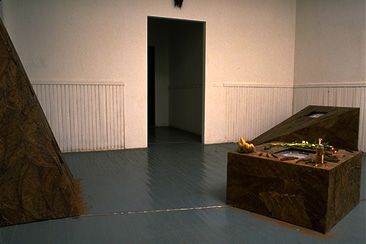 Saint
Barbara is Shango's syncretization. She was identified with Shango because she
has a cup in one hand (Shango's mortar), a sword (his axe) in the other, and
a castle at her feet. Her mantle is Red, her tunic white, and she is associated
traditionally with thunder and lightning. She is also the patroness of artillerymen.
Once again, a virgin and a martyr. Her legend dates back to the 7th century.
She was the daughter of Dioscorus, who kept her beauty guarded. When she professed
Christianity to her father, a pagan, he was so enraged that her ordered her
to be tortured and beheaded. Dioscorus himself performed the execution, and
on his way home was struck by lightning and reduced to ashes. She is venerated
as one of the 14 Auxiliary Saints, the Holy Helpers, and is invoked in thunderstorms.
Saint
Barbara is Shango's syncretization. She was identified with Shango because she
has a cup in one hand (Shango's mortar), a sword (his axe) in the other, and
a castle at her feet. Her mantle is Red, her tunic white, and she is associated
traditionally with thunder and lightning. She is also the patroness of artillerymen.
Once again, a virgin and a martyr. Her legend dates back to the 7th century.
She was the daughter of Dioscorus, who kept her beauty guarded. When she professed
Christianity to her father, a pagan, he was so enraged that her ordered her
to be tortured and beheaded. Dioscorus himself performed the execution, and
on his way home was struck by lightning and reduced to ashes. She is venerated
as one of the 14 Auxiliary Saints, the Holy Helpers, and is invoked in thunderstorms.
 All
this reminded me of something that happened nine years ago. It was a very hot
and humid summer. I lived on Seventh Street between B and C. I went out to get
some groceries. At St. Marks Place I stopped and browsed around at what was
being sold on the street. Lots of junk, as usual, hot bicycles and other wares.
And there, in the middle of the chaos was sitting a young man, clean shaven,
dressed in black. In front of him on the pavement was a piece of blue velvet
on top of which were three or four religious pieces. I bought a silver cross
from him and left. On my way home I heard some Latin music and singing from
a small church. There was a man standing at the door. I wanted to take a peek.
He said: "Come in, come in." I stepped in. A young girl with a pretty face in
a white lace dress approached me. She said "I will translate to you; I will
be your Guide." She took me by the hand and sat me down, next to her. I was
enjoying the music, singing with percussion, congas and guitars. It was wonderful.
I turned to the girl and told her that it gave me shivers how beautiful it was.
She said that meant I was in the presence of God, then got up, went to the front
and whispered something in the priest's ear. Then the priest came to the microphone
and spoke. People started turning around and looking at me. His speech became
more and more passionate, he pointed at me. The priest said that he had a message
from God and that I was sent to them to be purified from Sin. He asked me to
step to the altar. I had no way out, so I proceeded. I came to the front, he
told me to lean down. A woman was on the other side of him. They laid their
hands on me and started screaming for the Devil to come out. Then they started
playing a rhythm on the drums and chanting I looked to the left, to the right;
people were turning in circles like dervishes, going into a frenzy. A woman
was crying. They poured water on the ground, on me. Then, slowly everyone settled
down. I gave the cross I had bought earlier to the girl, excused myself, took
my groceries and left. As I crossed the street to my door, put the key in, a
torrential flood of rain suddenly descended. This sent a chill through me; I
ran up all six flights of stairs in one breath. When I walked in my lower body
was covered with blood.
All
this reminded me of something that happened nine years ago. It was a very hot
and humid summer. I lived on Seventh Street between B and C. I went out to get
some groceries. At St. Marks Place I stopped and browsed around at what was
being sold on the street. Lots of junk, as usual, hot bicycles and other wares.
And there, in the middle of the chaos was sitting a young man, clean shaven,
dressed in black. In front of him on the pavement was a piece of blue velvet
on top of which were three or four religious pieces. I bought a silver cross
from him and left. On my way home I heard some Latin music and singing from
a small church. There was a man standing at the door. I wanted to take a peek.
He said: "Come in, come in." I stepped in. A young girl with a pretty face in
a white lace dress approached me. She said "I will translate to you; I will
be your Guide." She took me by the hand and sat me down, next to her. I was
enjoying the music, singing with percussion, congas and guitars. It was wonderful.
I turned to the girl and told her that it gave me shivers how beautiful it was.
She said that meant I was in the presence of God, then got up, went to the front
and whispered something in the priest's ear. Then the priest came to the microphone
and spoke. People started turning around and looking at me. His speech became
more and more passionate, he pointed at me. The priest said that he had a message
from God and that I was sent to them to be purified from Sin. He asked me to
step to the altar. I had no way out, so I proceeded. I came to the front, he
told me to lean down. A woman was on the other side of him. They laid their
hands on me and started screaming for the Devil to come out. Then they started
playing a rhythm on the drums and chanting I looked to the left, to the right;
people were turning in circles like dervishes, going into a frenzy. A woman
was crying. They poured water on the ground, on me. Then, slowly everyone settled
down. I gave the cross I had bought earlier to the girl, excused myself, took
my groceries and left. As I crossed the street to my door, put the key in, a
torrential flood of rain suddenly descended. This sent a chill through me; I
ran up all six flights of stairs in one breath. When I walked in my lower body
was covered with blood. The
Havana cigar is considered by connoisseurs to be the creme de la creme. It has
been a forbidden fruit since 1959, when the U.S. put an embargo on Cuban tobacco.
And the symbol of the capitalist world, many times seen in Communist caricatures,
suddenly became readily available in the Soviet Union. And so Cuban magic traveled
to Russia. Meanwhile Castro recently received an award from the United
The
Havana cigar is considered by connoisseurs to be the creme de la creme. It has
been a forbidden fruit since 1959, when the U.S. put an embargo on Cuban tobacco.
And the symbol of the capitalist world, many times seen in Communist caricatures,
suddenly became readily available in the Soviet Union. And so Cuban magic traveled
to Russia. Meanwhile Castro recently received an award from the United The
Yoruba tradition, as well as the Indian, was written down for the first time
when it came to Cuba. Familiar symbols began to emerge as I read about Shango.
Shango is a storm deity of the Yoruba. Each town or village in Nigeria has its
own Orisha who acts as a patron saint and protector of the people. Shango is
worshipped in the city of Oyo. This divinity was once a king, a strong ruler
and a great doctor. But he was also tyrannical. He could kill people by breathing
fire from his mouth.
The
Yoruba tradition, as well as the Indian, was written down for the first time
when it came to Cuba. Familiar symbols began to emerge as I read about Shango.
Shango is a storm deity of the Yoruba. Each town or village in Nigeria has its
own Orisha who acts as a patron saint and protector of the people. Shango is
worshipped in the city of Oyo. This divinity was once a king, a strong ruler
and a great doctor. But he was also tyrannical. He could kill people by breathing
fire from his mouth. Saint
Barbara is Shango's syncretization. She was identified with Shango because she
has a cup in one hand (Shango's mortar), a sword (his axe) in the other, and
a castle at her feet. Her mantle is Red, her tunic white, and she is associated
traditionally with thunder and lightning. She is also the patroness of artillerymen.
Once again, a virgin and a martyr. Her legend dates back to the 7th century.
She was the daughter of Dioscorus, who kept her beauty guarded. When she professed
Christianity to her father, a pagan, he was so enraged that her ordered her
to be tortured and beheaded. Dioscorus himself performed the execution, and
on his way home was struck by lightning and reduced to ashes. She is venerated
as one of the 14 Auxiliary Saints, the Holy Helpers, and is invoked in thunderstorms.
Saint
Barbara is Shango's syncretization. She was identified with Shango because she
has a cup in one hand (Shango's mortar), a sword (his axe) in the other, and
a castle at her feet. Her mantle is Red, her tunic white, and she is associated
traditionally with thunder and lightning. She is also the patroness of artillerymen.
Once again, a virgin and a martyr. Her legend dates back to the 7th century.
She was the daughter of Dioscorus, who kept her beauty guarded. When she professed
Christianity to her father, a pagan, he was so enraged that her ordered her
to be tortured and beheaded. Dioscorus himself performed the execution, and
on his way home was struck by lightning and reduced to ashes. She is venerated
as one of the 14 Auxiliary Saints, the Holy Helpers, and is invoked in thunderstorms.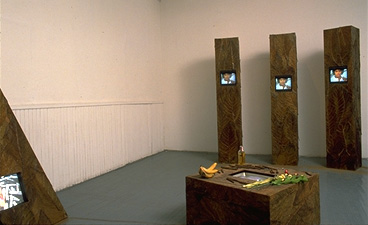 I
got in touch with Emilia, to tell her how much I'd discovered since we'd first
met. She somehow didn't share my enthusiasm, then shocked me by saying that
she didn't smoke cigars anymore and didn't want anything to do with Santeria.
Apparently the man who had introduced her to Santeria had been playing with
her head, leaving chicken feathers in front of her doorstep and blowing smoke
into her apartment. She said she was choking one night and was very scared.
In fact, a few of my friends had expressed concern that I had gotten involved
with the subject. I felt that I had my own spiritual strength to draw on and
since my motives were pure, there would be no place for attack. And the practitioners
had magic and divination at their disposal; they could have thrown coconut shells
and seen what I was all about.
I
got in touch with Emilia, to tell her how much I'd discovered since we'd first
met. She somehow didn't share my enthusiasm, then shocked me by saying that
she didn't smoke cigars anymore and didn't want anything to do with Santeria.
Apparently the man who had introduced her to Santeria had been playing with
her head, leaving chicken feathers in front of her doorstep and blowing smoke
into her apartment. She said she was choking one night and was very scared.
In fact, a few of my friends had expressed concern that I had gotten involved
with the subject. I felt that I had my own spiritual strength to draw on and
since my motives were pure, there would be no place for attack. And the practitioners
had magic and divination at their disposal; they could have thrown coconut shells
and seen what I was all about.